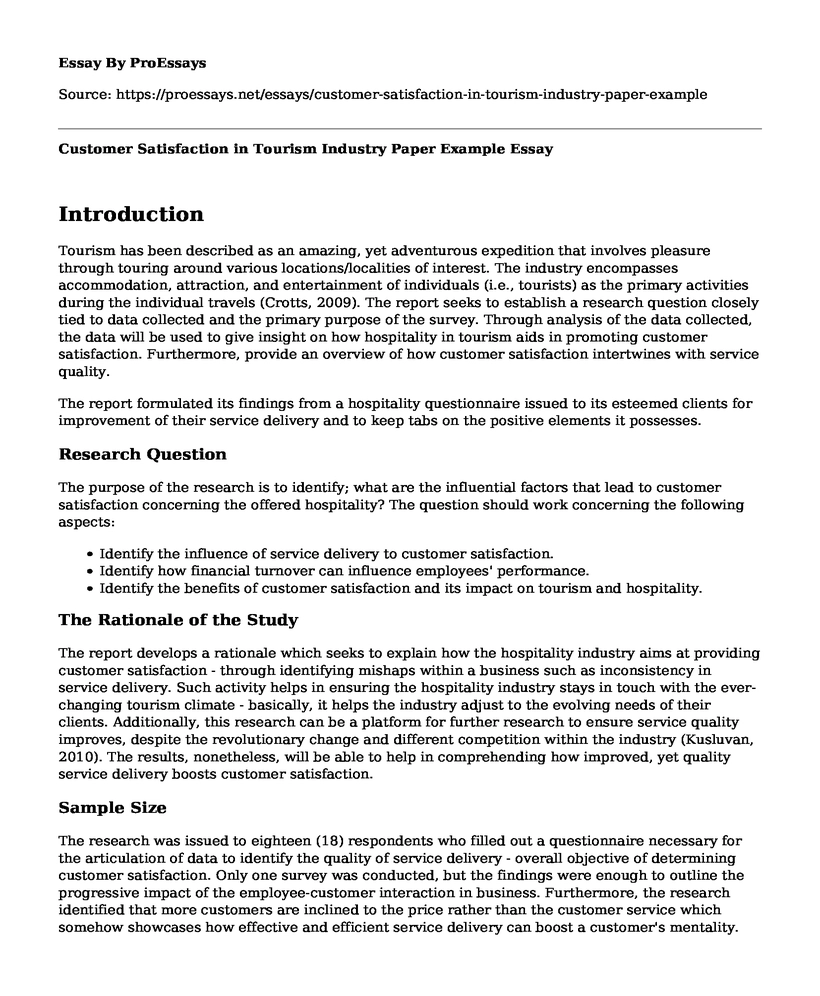Introduction
Tourism has been described as an amazing, yet adventurous expedition that involves pleasure through touring around various locations/localities of interest. The industry encompasses accommodation, attraction, and entertainment of individuals (i.e., tourists) as the primary activities during the individual travels (Crotts, 2009). The report seeks to establish a research question closely tied to data collected and the primary purpose of the survey. Through analysis of the data collected, the data will be used to give insight on how hospitality in tourism aids in promoting customer satisfaction. Furthermore, provide an overview of how customer satisfaction intertwines with service quality.
The report formulated its findings from a hospitality questionnaire issued to its esteemed clients for improvement of their service delivery and to keep tabs on the positive elements it possesses.
Research Question
The purpose of the research is to identify; what are the influential factors that lead to customer satisfaction concerning the offered hospitality? The question should work concerning the following aspects:
- Identify the influence of service delivery to customer satisfaction.
- Identify how financial turnover can influence employees' performance.
- Identify the benefits of customer satisfaction and its impact on tourism and hospitality.
The Rationale of the Study
The report develops a rationale which seeks to explain how the hospitality industry aims at providing customer satisfaction - through identifying mishaps within a business such as inconsistency in service delivery. Such activity helps in ensuring the hospitality industry stays in touch with the ever-changing tourism climate - basically, it helps the industry adjust to the evolving needs of their clients. Additionally, this research can be a platform for further research to ensure service quality improves, despite the revolutionary change and different competition within the industry (Kusluvan, 2010). The results, nonetheless, will be able to help in comprehending how improved, yet quality service delivery boosts customer satisfaction.
Sample Size
The research was issued to eighteen (18) respondents who filled out a questionnaire necessary for the articulation of data to identify the quality of service delivery - overall objective of determining customer satisfaction. Only one survey was conducted, but the findings were enough to outline the progressive impact of the employee-customer interaction in business. Furthermore, the research identified that more customers are inclined to the price rather than the customer service which somehow showcases how effective and efficient service delivery can boost a customer's mentality. Nonetheless, most customers are more inclined to personal interaction with a franchise's employees, especially when in need of a particular task fulfilled.
Reflection on lessons learned from research
Quality in service delivery should be a fundamental requirement for any business that seeks to deliver outstanding customer satisfaction - one which complies with their demands/needs or expectations. Therefore, staff members should offer interest in identifying what a customer needs and ensure that their woes are attended to with immediate effect. Developing an interpersonal relationship, however, may not be an exemplary aspect amongst all clients but an employee should be keen and smart enough to identify possible ways to please the customer.
A researcher, on the other hand, should use ideal methods - example sampling techniques - to intensify collection and analysis of data for better results. Therefore, in addition to questionnaires, the research ought to have included stratified random sampling as a technique for better outcomes. The method provides a diverse representation of data ideal for hospitality industries since it focuses on different groups using criteria such as checklists, surveys, graphs, charts among others to quantify the level of service delivery in business.
Nonetheless, a valid questionnaire, if used, should be precise but one which focuses on critical issues that may resolve in the collection of necessary data for analysis. Additionally, questions such as "Are incentives necessary for efficient service delivery?" and "Rate the level of service delivery you need in a hotel." Ideally, questions that deal with personal information, which some customers might find offensive or ones which interfere with their privacy need to be excluded from a questionnaire. Such matters involve a customer's marital status, level of education, gender and age range.
References
Crotts, J. C., Mason, P. R., & Davis, B. (2009). Measuring guest satisfaction and competitive position in the hospitality and tourism industry: An application of stance-shift analysis to travel blog narratives. Journal of Travel Research, 48(2), 139-151.
Kusluvan, S., Kusluvan, Z., Ilhan, I., & Buyruk, L. (2010). The human dimension: A review ofhuman resources management issues in the tourism and hospitality industry. Cornell Hospitality Quarterly, 51(2), 171-214.
Cite this page
Customer Satisfaction in Tourism Industry Paper Example. (2022, May 17). Retrieved from https://proessays.net/essays/customer-satisfaction-in-tourism-industry-paper-example
If you are the original author of this essay and no longer wish to have it published on the ProEssays website, please click below to request its removal:
- Implementation of Public Health Campaign: Timeline/Milestones and Marketing Strategies
- Paper Example on Just-In-Time Technique in Supply Chain Management
- Managing Operations and the Supply Chain Paper Example
- Essay on Increase Visits to Dunedin Literary Walking Tours: Attracting New Clients
- Global Operations Management: Plastic Bottle Supply Chain Challenge - Essay Sample
- Essay Example on Differentiation: A Vital Strategy for Market Leadership
- Coffee Demand Soars: Supply Chain Management Innovates to Compete - Free Paper







